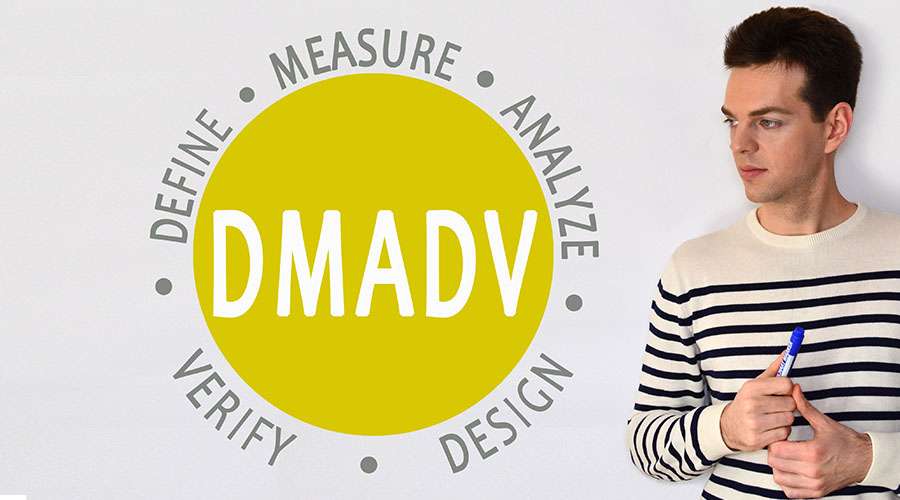Every business should have a streamlined strategy before launching a new service or product line. All stakeholders involved in the latest project development must work in sync to deliver what will meet your customers’ requirements. DMADV is a framework that allows you to manage such development processes seamlessly.
DMADV is part of the Six Sigma methodology, which, when implemented correctly, ensures zero wastage of time and resources for businesses. With DMADV Six Sigma, you can deploy efficient production strategies and improve the working process within the organization.
Whether you are a project leader working for a client or planning a new product, service, or process for your business, knowledge of DMADV will give you an added advantage. This guide highlights the basics of DMADV for easy understanding of this methodology. It also shares a Lean Six Sigma program you can take to master this methodology.
Let’s dive in!
What is DMADV?
DMADV is a Six Sigma framework used in new product/service/process designing. It is also known as Design for Six Sigma (DFSS). It focuses on customers’ requirements and makes your team ideate the right strategies in the first development phase.
DMADV is the acronym for the five phases of product or service development: Define, Measure, Analyze, Design, and Verify.
You can rethink flawed processes, redesign problematic products, ensure all stakeholders are on the same page with an entirely new product or service, and more with DMADV.
Another similar Six Sigma process, DMAIC, is available to improve the quality of an existing product or service. DMAIC stands for Define-Measure-Analyze-Improve-Control. After creating a product or service with DMADV analysis, you can use the DMAIC framework for further improvement with an extensive customer-centric approach.
Also Read: Six Sigma in Healthcare: Concepts, Benefits and Examples
What is DMADV Used For?
DMADV Six Sigma is used for redesigning or creating a new product or service. You can optimize your production per client or customer requirements with DMADV tools. As mentioned, it involves five stages of a production process. We have explained the use of each stage in detail. Have a look.
Define
In this phase, project managers discuss the goals and customer/client requirements for the product or service in this stage. The whole development process of the product depends on it. The team collects data from various sources like customer reviews, sales department, research information, and previously stored data to define the project details as accurately as possible. With all this information, the goal is to optimize the product design as the consumer wants and is willing to pay for it.
Measure
Once the project specifications are defined, the next step is to create nodes and collect data depending on them. That’s how you can construct a customer-defined specification list and ensure the product meets first-phase customer requirements. In this phase, a few characteristics are measured- customer-centric quality standards (CTQ), manufacturing capacity, risk assessments, and product capabilities. A DMADV-improved process or product will include all these measurements.
Analyze
This step analyzes the projected product or service to find better strategies for attaining the objectives. You must detect the product and process flaws while analyzing and prototyping the improved one. All stakeholders perform in this stage. The production and testing teams evaluate the final product or service to provide a foundation for improvement. Then, the leaders use data to discover process adjustments that enhance product quality. Finally, the teams decide on the procedures and make modifications.
Design
Once the analysis is ready, use the findings to design your product, service, or process. You may perform several revisions of the analytical data to compare the new design to the required criteria. The test members of your team should next evaluate new designs’ taking client satisfaction as the benchmark. All the internal testing for necessary design modifications should be performed per the client’s needs.
Verify
Verifying consumer satisfaction is the fifth phase of DMADV. It ensures the product is developed while maintaining the required standard. You should keep integrating customer inputs and updating the product or service after launch to imply this verification stage correctly. No matter how often you need to verify your production, the end goal will always be a product that satisfies all client needs.
The Advantages of DMADV
The structured problem-solving methodology of DMADV Six Sigma has several advantages. Here is a list of them:
- Customer-focused production: DMADV strongly emphasizes understanding and meeting customer needs throughout the design process. Hence, you can ensure your complete production process is consumer-focused.
- Systematic approach: The DMADV methodology provides a step-by-step process for developing new products or processes, which reduces the risk of missing essential requirements. With such a systematic approach, all stakeholders can work together to produce results quickly.
- Data-driven solutions: This framework relies heavily on data to guide decision-making throughout the design process. It leads to more objective-oriented and informed decisions.
- Reduced waste and cost: DMADV tools can help you increase efficiency and profitability by focusing on critical requirements and identifying unnecessary resource wastage.
- Improved product quality: DMADV rigorously analyzes a product or service that helps you ensure the result is high quality and meets customer expectations.
- Competitive advantage: When you design a new product or service using DMADV, it gets automatically tested for customer satisfaction. This way, you gain an edge over your competitors.
- Continuous improvement: As DMADV allows you to rethink product designs, you can use it for continuous product/service improvement.
Also Read: Six Sigma Principles: Process Implementation and Optimization
Examples of DMADV
DMADV is used widely for streamlined production across different industries. Here are a few examples of how the DMADV methodology shapes multiple sectors’ products, services, or process design. Let’s take a look.
| Industry | Product/Process/Service | Role of DMADV |
| Healthcare | A hospital wants to improve the patient intake process to reduce wait times and increase patient satisfaction. | DMADV defines the problem, measures the current process, analyzes the data, designs a new method that meets patient needs, and verifies it by testing with a small group of patients. This results in creating a process or service that meets patient requirements. |
| Automotive | An automobile manufacturer wants to develop a new fuel-efficient engine to meet stricter emissions standards. | DMADV identifies the engine’s requirements, measures the technology’s current state, analyzes alternative engine designs, designs the new engine, and verifies the engine performance through testing. It results in a new engine design that meets the emissions standards and is more fuel-efficient. |
| Food and Beverage | A snack company wants to create a new healthy snack that appeals to health-conscious consumers. | DMADV finds out the target market and their preferences, measures the current market for healthy snacks, analyzes alternative ingredients and recipes, designs the new snack, and verifies its taste and nutritional value with focus groups. This way, a new healthy snack is produced that meets the target market’s preferences and is appealing to health-conscious consumers. |
| Information Technology | A software company wants to develop a new application for managing customer data. | The DMADV process marks the requirements for the application, measuring the current state of customer data management, analyzing alternative software designs, designing the new software, and verifying the software’s functionality through testing. Finally, the organization gets a new software application that efficiently manages customer data and is user-friendly. |
| Retail | A retailer wants to develop a new inventory management system to reduce overstocking and understocking of products. | Using DMADV tools, retailers can determine the actual requirements for the inventory management system, measure its current state, analyze alternative system designs, develop the new system, and verify its performance through testing. It allows the development of an inventory management system that optimizes different levels and reduces waste. |
When to Use the DMADV Methodology?
DMADV Six Sigma is most useful when designing a new product or process that meets specific customer/client needs while ensuring zero wastage and streamlined production.
Here are some instances of its application:
- New product development: While developing a new product that meets specific customer-defined requirements, DMADV can help you ensure the result is high quality and caters to all needs.
- Process redesign: DMADV can help you identify and redesign faulty processes according to consumer requirements. This will allow you to build a more effective and efficient product or service.
- Regulatory compliance: An organization must comply with specific regulatory requirements, like environmental regulations or safety standards. DMADV can help you structure and implement a new process that meets those needs.
- Competitive pressure: When you need to outperform your competitors, DMADV enables you to find out where they could be improved to serve the customers. You can integrate those processes into your business with a thorough DMADV analysis of consumers’ wants.
- Quality improvement: If an organization wants to improve its existing products or services, DMADV can help identify the ones of higher quality that better meet customer needs.
Also Read: What is Zero Defect? What it Means, its Applications, and Limitations
What’s the Difference Between DMADV and DMAIC?
Although DMADV and DMAIC are part of the Lean Six Sigma philosophy and share some similarities, they are markedly different. The chief difference between DMADV and DMAIC is that the former focuses on developing new processes, products, or services, while the latter is used to improve an existing process. Thus, DMADV measures customer needs and specifications, while DMAIC measures the process’s performance. DMAIC focuses on enhancing business processes to reduce and eliminate defects, and DMADV develops business models to meet customers’ requirements.
DMADV is a verification and design process for new projects, while DMAIC is an improvement and control process for preexisting models.
All About DMADV Best Practices
The following best practices are essential to the DMADV process.
- Engagement. At the start, identify who should be on the core and extended teams. Most DMADV projects need a wide array of engaged functions.
- Understand your customer’s requirements. Since you’re just starting, take the time to fully understand what the customer needs and how, based on your findings, you will be able to measure key metrics and CTQs.
- Divide the project into manageable pieces. Given the method’s intensity, allocate some time for the team to absorb and internalize all the process’s activities and outcomes. Expect profoundly serious diminishing returns if meetings are too long or frequent.
Also Read: Quality Management Breakdown: What is Measurement System Analysis?
Get Online Six Sigma Training to Gain DMADV & Other Six Sigma Skills
Every detail mentioned above defines how DMADV methodology can help you redesign existing products or services and create a new one after deciding its market fit. But you must remember the use of DMADV will entirely depend on what industry you are serving and what product or service you want to develop. For example, the DMADV methodology benefits industries where innovation and quality are critical, such as healthcare, finance, and technology.
Whether you’re an aspiring Lean Six Sigma expert or want to improve organizational efficiency, you should know about DMADV. It’s a robust and specialized methodology, and mastering it can set you apart from other Lean Six Sigma professionals and enhance your career prospects.
Online Six Sigma training will help you use DMADV like a pro and efficiently build new products or services. A post graduate program in Lean Six Sigma is one such training offered by Simplilearn in collaboration with the University of Massachusetts. In this program, you’ll get an in-depth and comprehensive understanding of the principles, tools, and techniques of Lean Six Sigma and its applications in different industries. You will also acquire hands-on training and work on real-world projects, where you’ll learn to apply Lean Six Sigma concepts, tools, and techniques practically.
On completing the course, you’ll receive a certificate from the prestigious UMass Amherst, enhancing your CV and making you valuable to your current or future employers.
Indeed.com shows project managers in the United States earn a yearly average of $87,640, with a low range of $56,256 and a maximum range of $136,532.
Ready to become a Lean Six Sigma expert in six months? Enroll to get started!
FAQ
Q: What is the DMADV process?
A: The DMADV process is:
- Define the requirements or changes
- Measure the required resources
- Analyze the resources to ensure they are enough
- Design a plan of action to initiate the change
- Verify if the process and results are working in your favor
Q: What is the difference between DMAIC and DMADV?
A: DMADV is a verification and design process targeted at new projects, while DMAIC is an improvement and control process for pre-existing models.
Q: What is an example of DMADV?
A: A team could use DMADV to create new packaging for a product or change an existing package.
Q: What are the advantages of DMADV?
A: The advantages are:
- It’s customer-driven
- It helps achieve maximum customer satisfaction while increasing profits
- It helps to reduce defects
- It focuses on the whole production and planning process
- It helps establish areas for improvement before it encounters defects
You might also like to read:
Six Sigma Calculator: How to Use It?
Failure Mode and Effects Analysis: A Complete Guide
Six Sigma Certification Cost: Here’s A Comprehensive Guide







